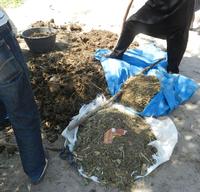Transition Agroécologique du Maraîchage en Afrique sub-saharienne (Agro-ecological transition of market gardening in sub-Saharan Africa)
Last update: 27 March 2018
There is strong demand from society throughout sub-Saharan Africa for the market gardening sector to make the agro-ecological transition. In response to the negative impacts of uncontrolled intensification, nutrition and food safety are now of growing concern for all the stakeholders in the sector, from producers to consumers, and even international bodies such as the FAO.
Through a participatory approach, the TAMA project intends to provide an opportunity for federating the expertise that exists within various CIRAD units, and also at numerous partner organizations in both North and South (from research, development and civil society), to work to co-design new, sustainable agro-ecological production systems.
The TAMA project set out to tackle two main challenges: (i) improving the safety, nutrition and economic security of sub-Saharan farming communities and consumers; (ii) protecting the environment in a context of global change that is having a significant impact on the market gardening sector.
Population growth and subsequent urbanization have resulted in the shrinkage of the areas traditionally used for crops on urban fringes, and in a need to boost market garden crop production through intensification. This means growing, often uncontrolled use of chemical inputs with adverse effects on human health and the environment that are of increasing concern for both producers and consumers.
The issues for the project are thus to (i) work with market gardening sector stakeholders to build new agro-ecological production systems, (ii) ensure greater sustainability of market gardening on an environmental, social and economic level, and (iii) respond to strong demands from society in terms of food quality and safety.
Those demands are situated at both ends of the stakeholder chain. At one end, producers, who want to make a living and avoid taking risks handling dangerous chemicals. At the other, consumers, who want to protect their health by eating healthy, safe foods (nutritional value, absence of toxic residues). There are also citizens keen to pass on a healthy environment to their children.
Last update: 27 March 2018

